In May 2025 the Official Aotearoa Music Chart turned 50 years old. Since its creation in 1975, it has kept evolving. At the 50 year anniversary the Chart includes 11 different weekly lists, covering Current and Catalogue Single and Album releases, New Zealand Artist charts, a specialist Te Reo Māori chart and the Hot Charts (a form of trending or viral chart). Globally, the New Zealand music charts are the first national charts in the world to go live each week, published at 4pm on a Friday.
History
Since 2 May 1975 New Zealand has had an official music chart, based on a weekly survey that tracks music sales to measure current music popularity.
Although the medium and methodology have evolved over the years from a majority vinyl 7" and vinyl LP or cassette mix to the current mix of physical and digital (CD, downloads and more recently, streaming) both the “single” and “album” remain constant.
There had been charts before but only a Singles Chart went nationwide, while album listings were compiled regionally by radio stations at different times. New Zealand had no comprehensive national system for tracking music popularity until 1975.
The seeds of the current Official New Zealand Music Chart date back to 1973 when Phonogram’s John McCready suggested to the industry body NZFPI (New Zealand Federation of Phonographic Industries) a sales chart similar to those operating in the UK and USA.
In 1975 the initial chart contract was awarded to Heylen Research who surveyed 95 retail outlets nationwide with a sample of 80 being used in any given week to gauge sales. The weekly random sampling was seen as a way to discourage chart “hyping”.

The very first album chart
The official first chart, a Top 40, went live on Friday 2 May 1975 with Helen Reddy’s ‘Free And Easy’ and Bob Dylan’s Blood On The Tracks in the respective No.1 single and album spots. There were five local acts in the Singles Chart that week (John Hanlon’s ‘Apple Wine’ listed highest at No.13) and just one local album, the self-titled Space Waltz, listed.

The very first singles chart
The first local act to top the National Sales Chart was 21-year-old Dargaville-born Mark Williams on 27 June 1975 with ‘Yesterday Was Just The Beginning Of My Life’. He made the top again two years later with ‘It Doesn’t Matter Anymore’ in May 1977.
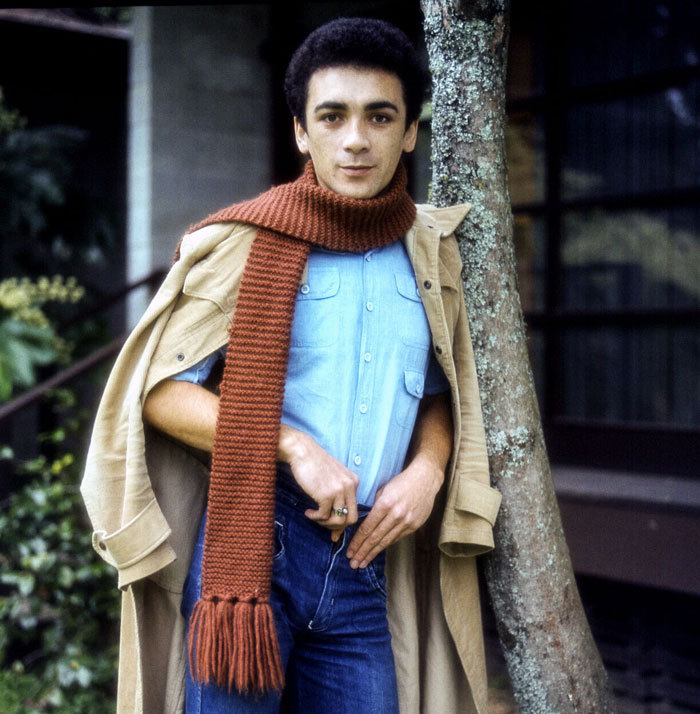
Mark Williams was the first New Zealand artist to top the New Zealand Top 40, with Yesterday Was Just The Beginning Of My Life in June 1975
The first New Zealand act to claim a No.1 album was duo Bill & Boyd, who had relocated to Australia, with their self-titled Bill & Boyd.
Radio New Zealand discontinued their Top 20 from 16 May 1975, adopting the new chart for their regular Top 10 countdown across their network Thursday evenings at 7pm hosted by Peter Sinclair.
A regular Top 20 countdown began on RNZ’s community network in the late 70s on Wednesdays, the day the chart was compiled. And in the mid 80s the entire Top 40 featured on Sunday afternoons, again on RNZ’s community network.
The chart’s first TV exposure came almost immediately when Television One began Ready To Roll, a half-hour show hosted by Roger Gascoigne, just as video clips began being used to promote singles.
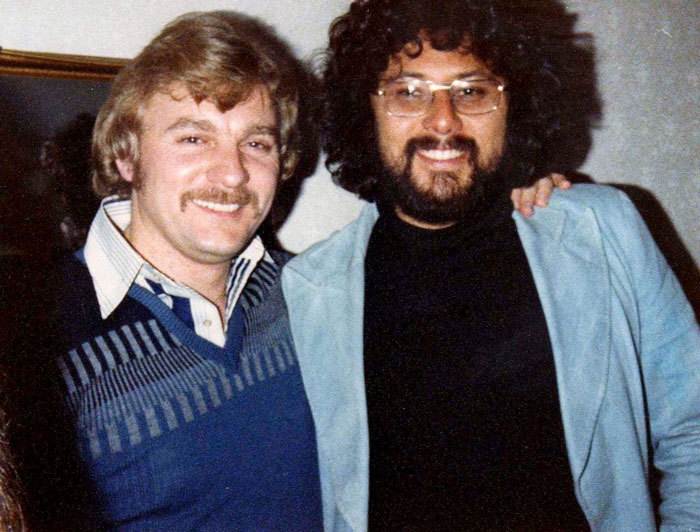
John Hanlon with his producer Mike Harvey (left). John Hanlon's Apple Wine was the highest New Zealand single in the first Top 40 chart
In the early 80s RTR moved to 6pm Saturday nights before the news, becoming appointment viewing with video exposure influencing the next week’s chart. The show continued until 1994. There were a series of RTR-branded compilation albums as well.
In the 1990s the entire chart featured Sunday mornings on TV2 during television’s non-commercial period. For a time in the mid-2000s a local version of Top Of The Pops was produced live in Auckland using the Top 40 singles as its chart.

Jon Steven's Jezebel was No.1 at the end of 1979. For many years the last chart topper of the year would stay there for some four or five weeks until the chart survey began again in the next year. Jon Stevens remains the only New Zealand artist to knock himself off the top spot, when Montego Bay replaced Jezebel in 1980.
The last regular TV broadcast of the chart was on music channel C4 until its closure.
Printed copies of the chart were mailed to retail outlets across the country from the first chart and displayed instore. From February 1977 the chart was published in the Dominion Sunday Times weekly. Daily newspapers have carried Top 10 listings but can vary in publication dates.
1992 saw printed charts available for customers to pick up in record stores. This was replaced with a glossy poster version in April 2004. These were in circulation until 2007 when the chart moved to online publication, where it continues today at www.nztop40.co.nz.
Heylen continued to produce the chart until the NZFPI took chart compilation in-house, forming Record Publications Ltd in 1977. The following year the NZFPI became the Recording Industry Association of New Zealand (RIANZ).
The first methodology change to the chart occurred in 1979 when the Top 40 was extended and became a Top 50 for both albums and singles in the hope this would increase the opportunity for more local acts to achieve a ranking.
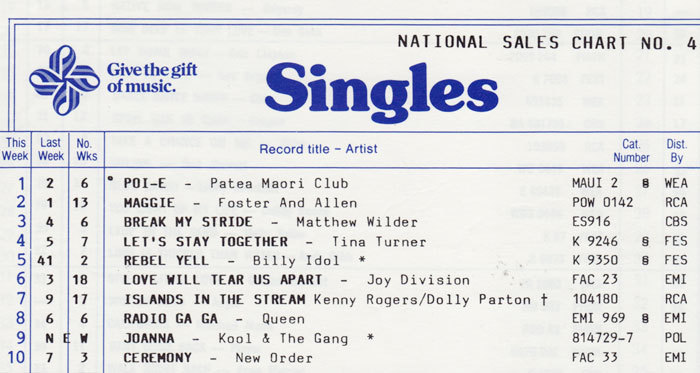
The Patea Māori Club's Poi-E was a smash in 1984, topping the chart with almost no airplay. Produced by Dalvanius, it was the biggest selling single of the year.
There were regional charts used by the record companies which weren’t published but were used by Record Company Sales Reps. These three charts were: North of the North Island, South of the North Island, and South Island. In 1986, CD sales were included in the charts.
There had long been a debate about including compilation albums in the main Albums chart. The TV-advertised 20 Solid Gold Hits, which started in 1972, was one of the nation’s most consistent sellers but had been ineligible for chart inclusion. This barrier was overcome in May 1980 when the first compilation chart was published for the first time, being the first new addition to the Chart stable. The first No.1 was Platinum Plus Volume 1, a rival series to 20 Solid Gold Hits.
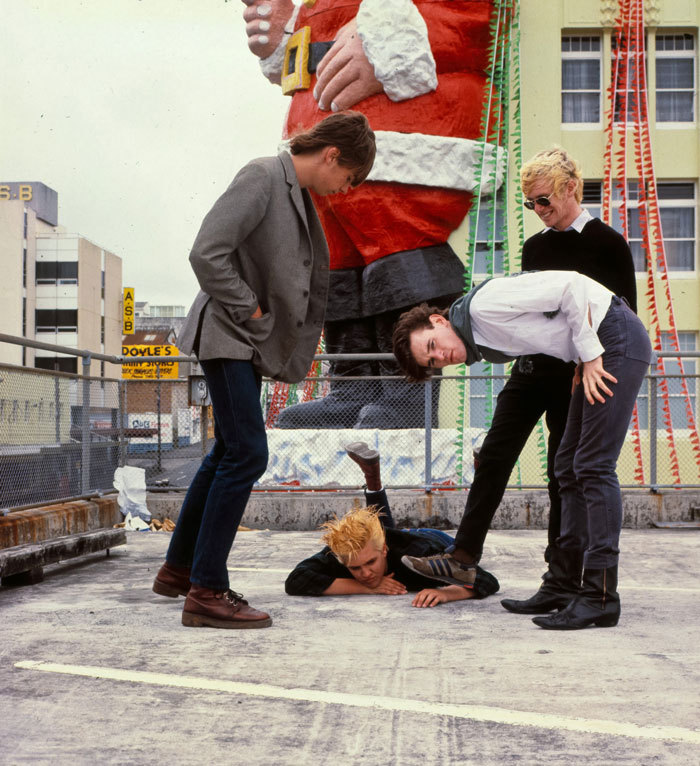
The Screaming Meemees' 1981 No.1 See Me Go was the first New Zealand record – single or album – to enter the charts in the top spot - Photo by Murray Cammick
As the name National Sales Chart (initial moniker for the NZ charts) implied, counting sales only meant that some of the era’s biggest songs did not always chart. And equally some of the top 10 sellers such as 1981’s 'Love Will Tear Us Apart' and 'Atmosphere' by Joy Division and the Dead Kennedys’ No.9 'Too Drunk To F*ck' were without commercial radio play.
This led to the radio industry starting its own charts, reflecting airplay rather than sales. First off came Kuhtze Countdown in the mid 80s compiled by Joe Gilfillan. This concept continued into the 90s as the Shake 30 and the Powerjam (both sponsored by Coca-Cola).
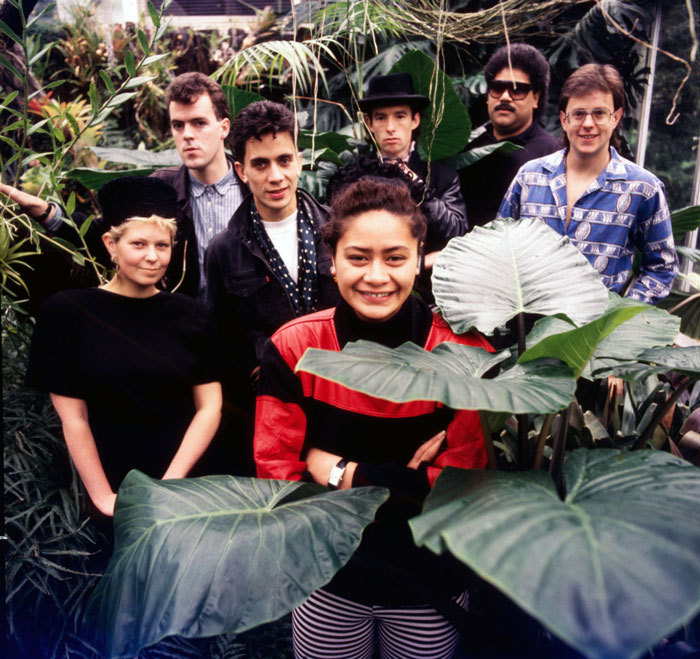
Wellington band The Holidaymakers' cover of Bill Withers' Sweet Lovers was the biggest hit of 1988, spending six weeks at No.1
In the mid 90s Paul Kennedy’s radio industry magazine Median Strip began publishing radio station playlists and later began compiling airplay charts. Thus the Radioscope100 and various format airplay charts came into being. Their success, coupled with the record companies’ move away from pressing singles, combined to trigger the first major chart change in 20 years of charts. Radio airplay became a factor in compiling the Singles Chart in October 1999 with S Club 7’s ‘Bring It All Back’ being the first “blended” No.1.

Auckland's 3 The Hard Way had New Zealand's first hip-hop No.1 with Hip Hop Holiday in 1994. A decade later they repeated the feat with It's On (Move To This), thus becoming the artist with the longest space between chart toppers. - Photo by Murray Cammick
In May 2004 the chart’s name changed to the Official New Zealand Music Chart with compilation moving from RIANZ’s Record Publications to independent company RadioScope (then Media Sauce). A complete overhaul saw data collection became electronic and immediate with charts compiled at the end of the sales period rather than a week later. Auditing was introduced and the Top 50 Albums and Singles reverted to their original Top 40 incarnation. Two new charts introduced: Top 10 DVDs and Top 10 Heatseekers (the next 10 uncharted album titles below the Top 40), the idea being to introduce more new music to the public.
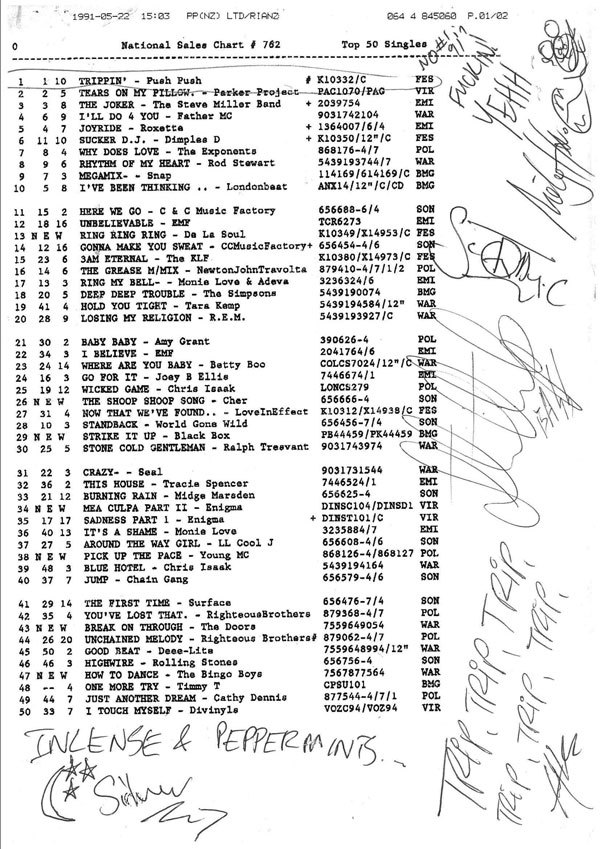
When Push Push hit the top in 1991 they were rather thrilled.
The world was changing and illegal downloading started to erode music sales. However, the industry embraced the digital age with legal downloads from the new iTunes NZ store, local providers Amplifier and Digirama delivering sales information to be included in the chart from May 2007.
The net result was the end of the physical single for the most part, but vastly increased single track sales each week. The first No.1 single on the first digital-inclusive chart was ‘Crawl’ by local band Atlas while the first digital-only chart-topper was Rihanna’s ‘Umbrella' on June 4, 2007.
The Top 40 Singles reverted to being a sales-only chart in wake of the changes with a new Top 10 Radio Airplay chart published.
September 2010 saw a chart rule change removing the requirement for a $20-plus retail price to be eligible for the Albums Chart to better reflect what was being bought by music fans. Previously, big sellers might not appear on the chart at all due to a pricing decision by one of the larger retailers.
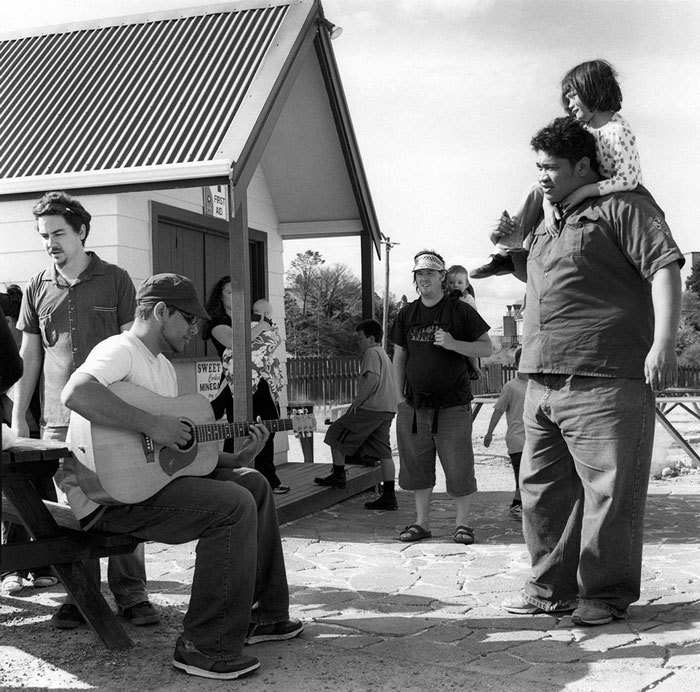
Fat Freddy's Drop dominated the New Zealand album charts in 2006 with Based On A True Story - Photo by Ans Westra
Just over a year later, two new charts were introduced to reflect the rise in the popularity of local acts with NZ Artist Albums and NZ Artist Singles surveys. Both were Top 20 lists with initial No.1s being Sir Howard Morrison’s The Definitive Collection and Six60’s ‘Don’t Forget Your Roots’ on the Albums and Singles respectively. At the same time, publication of both the Radio Airplay Top 10, Heatseekers and DVD charts ceased.
The speed at which the Official New Zealand Music Chart is published increased with the electronic collection of data. March 2013 saw the chart week move from a Friday to Thursday cycle with new releases instore or online on a Friday. This was seen as a logical step and it’s interesting to note that in 2015, the entire global music industry is set to switch to this model and champion “new music Friday” globally.

Smash Proof (featuring Gin Wigmore)'s Brother was No.1 for almost four months in 2009
The chart is now compiled during the day on Friday with publication just after 5pm.
The latest moves in the evolution of the Official New Zealand Chart involve the inclusion of streaming data. From November 2014 the Singles Chart began to reflect how many people now consume their music via digital streams rather than ever owning a physical or digital copy. In June 2016 more changes were made with the inclusion of streaming figures for the Album Chart. Statistics are collected from all major on-demand streaming services and added to the data already received by physical retailers and digital download retailers.
Reflecting the changing ways in which New Zealanders consume music, the charts began including YouTube views from 2018. Counted are views of full-music videos, or lyric videos, which contain the entirety of a song (user-generated content and clips containing just small portions of a song are not).
Changes to gold and platinum certification were introduced in June 2016. Albums are required to reach 7,500 SEA points (a combination of sales and streaming) to achieve gold and 15,000 points to achieve platinum, while single certifications were raised to 15,000 points for gold and 30,000 for platinum.
In April 2023 Recorded Music NZ added a brand new set of Catalogue Charts, issued each week alongside the existing charts.
“Albums and Singles now appear in one of two locations each week – a main Top40 Chart devoted to new and current releases or a brand new Catalogue Chart featuring the most popular older releases.
“The Top40 Charts will impose a strict 18-month limit on the recordings appearing there. The clock starts ticking from the first week a recording enters the chart and if, after 18 months, it is still performing it automatically moves to the Catalogue Charts instead, carrying its full chart history with it to continue on its journey toward historical chart longevity records.”
Recorded Music NZ Chart Compiler Paul Kennedy explained the changes: “In a streaming-dominated world in which old favourites are often on perpetual repeat for many music fans, some titles never leave the chart while a large quantity of very deserving new music never charts at all.
“By splitting the charts into two, we can continue to celebrate the most enduring albums and songs in their own new charts, while also freshening up the Top40.
“We hope these new Catalogue Charts will not only be a new additional tool for the industry but also an interesting insight for music fans by shining a light on the most enduring hits of years, and decades, gone by.”
And it’s a case of back-to-the-future as vinyl LPs make a comeback. Perhaps not in the same number of units as 1975 but they are making inroads again.
In May 2025 the Official New Zealand Music Chart turned 50 years old. Over time the charts have gone from summer shutdown to continual 52-week compilation, to near real time collation.
In November 2024 the charts were renamed the Official Aotearoa Music Charts. The name change coincided with a new website and new te reo Māori translations for each Chart title.
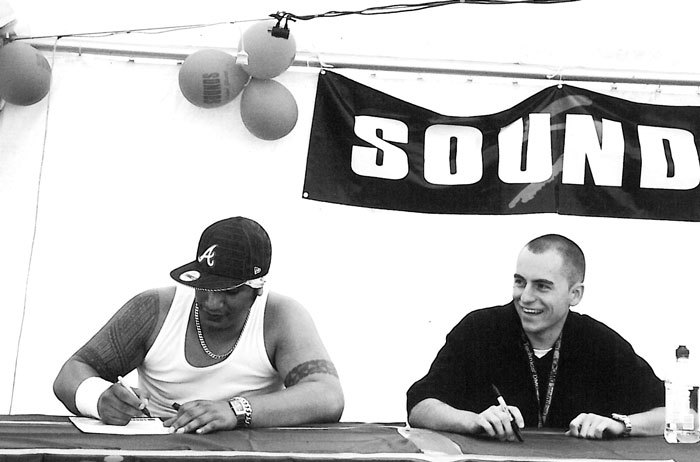
Scribe and P-Money signing autographs at the 2004 Big Day Out. Scribe's 2003 smash double A-side Not Many / Stand Up spent 12 weeks at No.1. P-Money has spent more weeks at No.1 as both a producer and an artist than any other New Zealand artist - photo by Gareth Shute
New Zealand No.1 Singles*
‘Yesterday Was Just The Beginning Of My Life’ – Mark Williams (1975)
‘It Doesn't Matter Anymore’ – Mark Williams (1977)
‘Tania (This Song Is For You)’ – John Rowles (1978)
‘Jezebel’ – Jon Stevens (1979)
‘Montego Bay’ – Jon Stevens (1980)
‘I Got You’ – Split Enz (1980)
‘Counting The Beat’ – The Swingers (1980)
‘The Bridge’ – Deane Waretini (1981)
‘See Me Go’ – The Screaming Meemees (1981)
‘How Great Thou Art’ – Sir Howard Morrison (1981)
‘E Ipo’ – Prince Tui Teka (1982)
‘Life Begins At 40’ – Dave and the Dynamos (1983)
‘Poi-E’ – Patea Maori Club (1984)
‘Room That Echoes’ – Peking Man (1985)
‘Sailing Away’ – All Of Us (1986)
‘Slice Of Heaven’ – Dave Dobbyn and Herbs (1986)
‘The Game Of Love’ – Tex Pistol (1987)
‘Sweet Lovers’ – The Holidaymakers (1988)
‘Nobody Else’ – Rikki Morris & Tex Pistol (1988)
‘Melting Pot’ – When The Cat's Away (1988)
‘Escaping’ – Margaret Urlich (1989)
‘Welcome To Our World’ – John Grenell (1990)
‘To Sir With Love’ – Ngaire (1990)
‘Trippin’’ – Push Push (1991)
‘Tears On My Pillow’ – The Parker Project (1991)
‘You Make The Whole World Smile’ – The Red Nose Project (1993)
‘The Heater’ – The Mutton Birds (1994)
‘Hip Hop Holiday’ – 3 The Hard Way (1994)
‘Can't Get Enough’ – Supergroove (1994)
‘George’ / ‘Cruise Control’ – Headless Chickens (1994)
‘How Bizarre’ – OMC (1996)
‘Chains' ’ – DLT feat. Che Fu (1996)
‘We Don't Know How Lucky We Are’ – Fred Dagg (1998)
‘Lost In Love’ – Deep Obsession (1998)
‘Without A Doubt’ / ‘Machine Talk’ – Che Fu (1998)
‘Silly Love Songs’ – Ardijah (1999)
‘Tonight’ – TrueBliss (1999)
‘Cold’ – Deep Obsession (1999)
‘Can You Hear Us’ – Neil Finn (1999)
‘One & Only’ – Deep Obsession (1999)
‘Lydia’ – Fur Patrol (2000)
‘Sophie’ – Goodshirt (2002)
‘Stand Up’ / ‘Not Many' Scribe (2003)
‘It's On (Move To This)’ – 3 The Hard Way (2003)
‘Dreaming’ – Scribe (2004)
‘They Can’t Take That Away’ – Ben Lummis (2004)
‘Fool's Love’ – Misfits of Science (2004)
‘Getting Stronger’ – Adeaze feat. Aaradhna (2004)
‘So Damn Beautiful’ – Michael Murphy (2004)
‘We Gon Ride’ – Dei Hamo (2004)
‘Stop The Music’ – P-Money feat. Scribe (2004)
‘Swing’ – Savage (2005)
‘Moonshine’ – Savage feat. Akon (2005)
'All I Ask’ – Rosita Vai (2005)
‘You Really Got Me’ – Boyband (2006)
‘Hold Out’ – Matt Saunoa (2006)
‘Crawl’ – Atlas (2007)
‘SPCA: A Very Silent Night’ – The Underdogs (2007)
‘Always On My Mind’ – Tiki Taane (2008)
‘Nesian 101’ – Nesian Mystik (2008)
‘Everything’ – P Money feat. Vince Harder (2008)
‘Brother’ – Smashproof feat. Gin Wigmore (2009)
‘Black Box’ – Stan Walker (2009)
‘You Got Me’ – J.Williams feat. Scribe (2010)
‘Young Blood’ – The Naked and Famous (2010)
‘Something In The Water’ – Brooke Fraser (2010)
‘Rise Up 2.0’ – Six60 (2011)
‘Love Love Love’ – Avalanche City (2011)
‘Somebody That I Used To Know’ – Gotye feat. Kimbra (2011)
‘Feel Inside (And Stuff Like That)’ – Flight of the Conchords (2012)
‘Come On Home’ – Titanium (2012)
‘Royals’ – Lorde (2013)
‘Tennis Court’ – Lorde (2013)
‘Bones’ – Ginny Blackmore (2013)
‘It's Worth It’ – Jackie Thomas (2013)
‘Holding You’ – Ginny Blackmore and Stan Walker (2014)
‘Freaks’ – Timmy Trumpet And Savage (2014)
‘Special’ – Six60 (2014)
‘Inside Out’ – Avalanche City (2015)
‘Green Light’ – Lorde (2017)
‘In the Air’ – L.A.B. (2020)
‘Savage Love (Laxed – Siren Beat)’ – Jawsh 685 and Jason Derulo (2020)
‘Why Oh Why’ – L.A.B. (2020)
‘All She Wrote’ – Six60 (2021)
* As at 1 May 2025. Note: (year) denotes year of No.1 chart position, which may differ from year of release
--
Explore the Official Aotearoa Music Charts archive